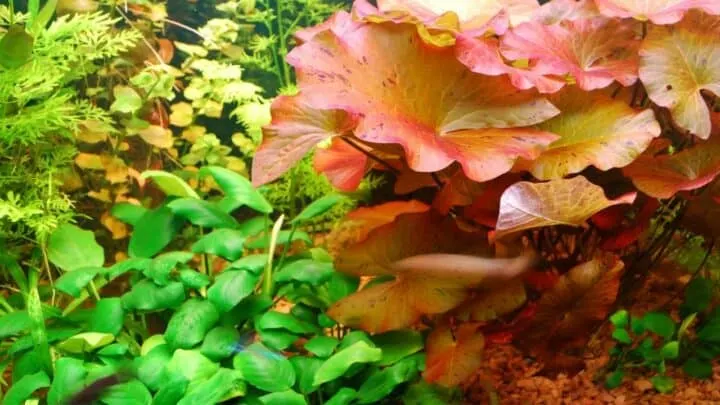Everyone wonders whether or not their aquarium plants can be grown in gravel. In truth, it depends completely on the species of the plant you want to grow.
Generally speaking, gravel is a great option to grow your plants in, but only a few aquarium plants can do well in it.
The following aquarium plants are some of the few that flourish in gravel.
Aquarium Plants that Grow in Gravel
- Amazon Sword
- Cryptocoryne Wendtii
- Madagascar Lace
- Java Fern
- Anubias
- Red Tiger Lotus
- Vallisneria
- Bucephalandra
- Dwarf Sagittaria
- Waterweeds
- Java Moss
- Marimo Moss Ball
Amazon Sword (Echinodorus grisebachii)
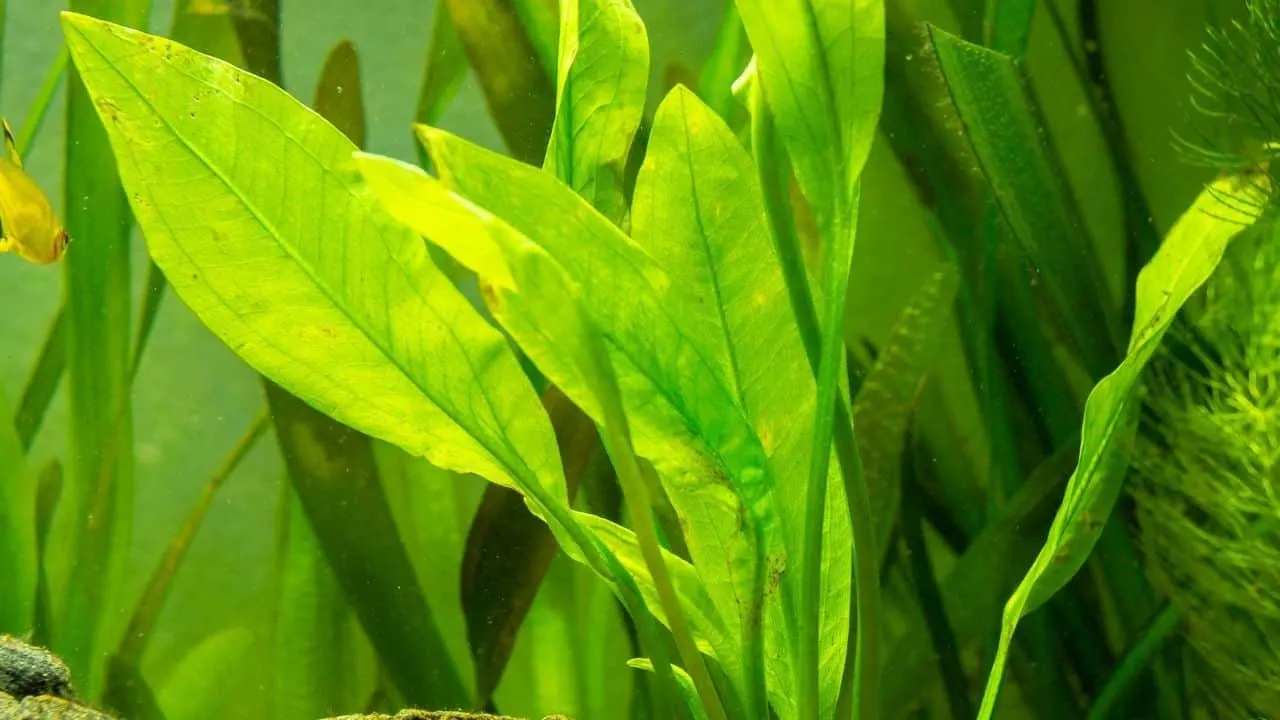
Amazon Sword’s a great plant to start with as it does not give beginners a hard time. Its light requirements are moderate, and it can survive under many different temperatures.
Amazon Sword has long sword-like leaves that you can grow in any aquarium.
-
-
-
- Common names: Amazon Sword
- Scientific name: Echinodorus grisebachii
- Common names: Amazon Sword
- Family: Alismataceae
- Temperature: 72 – 82 Degrees Fahrenheit (22 to 27 degrees Celsius)
- Family: Alismataceae
- Temperature: 72 – 82 Degrees Fahrenheit (22 to 27 degrees Celsius)
- Fertilizer: Needs regular doses of fertilizer through root tabs and iron-rich supplements
- Soil: Requires nutrient-rich soil
- Lighting: Medium to high
- Growth rate: moderate
- Placement: Background
-
Fertilizing your gravel is extremely important since it does not have any nutrients in it.
You can follow these tips to fertilize your Amazon Sword:
-
-
- Use liquid fertilizer
- Add fertilizer twice a week
- You can also add root tabs every three months
-
Cryptocoryne Wendtii
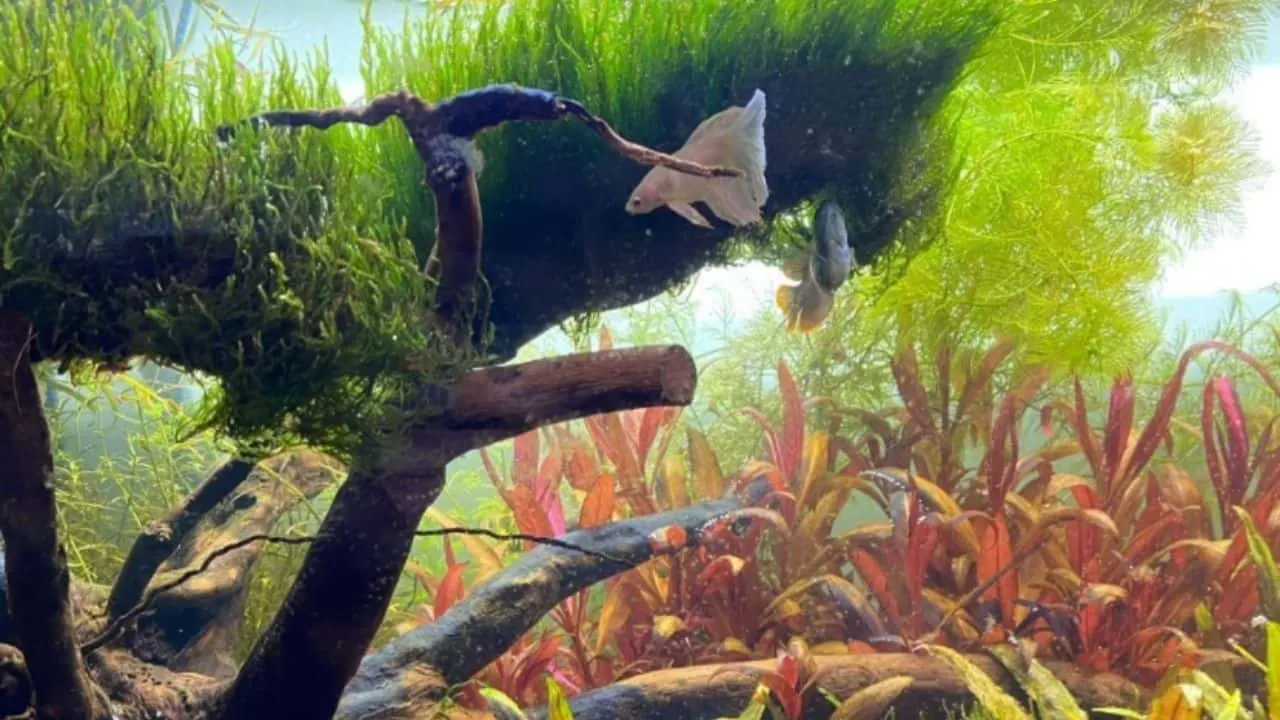
Photo Credit: @urban_country_nature on Instagram!
Cryptocoryne Wendtii is a popular aquarium plant primarily kept in gravel and does well in sand.
This plant comes in many different colors, so you do not have to buy simple green plants for your aquarium, as Cryptocoryne Wendtii is available in red as well.
-
-
- Common name: Crypt. Wendtii
- Scientific name: Cryptocoryne Wendtii
- Height: 6 inches (15 centimeters)
- Care: Easy
- Lighting needs: Low to Moderate
- Growth rate: Slow
- Additional CO2 required: No
- Recommended position: Foreground or Midground plant
- Fertilization: Root tabs
- pH: no specific pH requirements
-
This is a very undemanding plant; however, you need to root it down the soonest you can. Cryptocoryne Wendtii is a plant that forms large roots; thus, gravel is the best substrate for it.
Just make sure that there is a lot of gravel present and that the roots are placed firmly into the gravel (at least three inches deep).
Madagascar Lace (Aponogeton Madagascariensis)
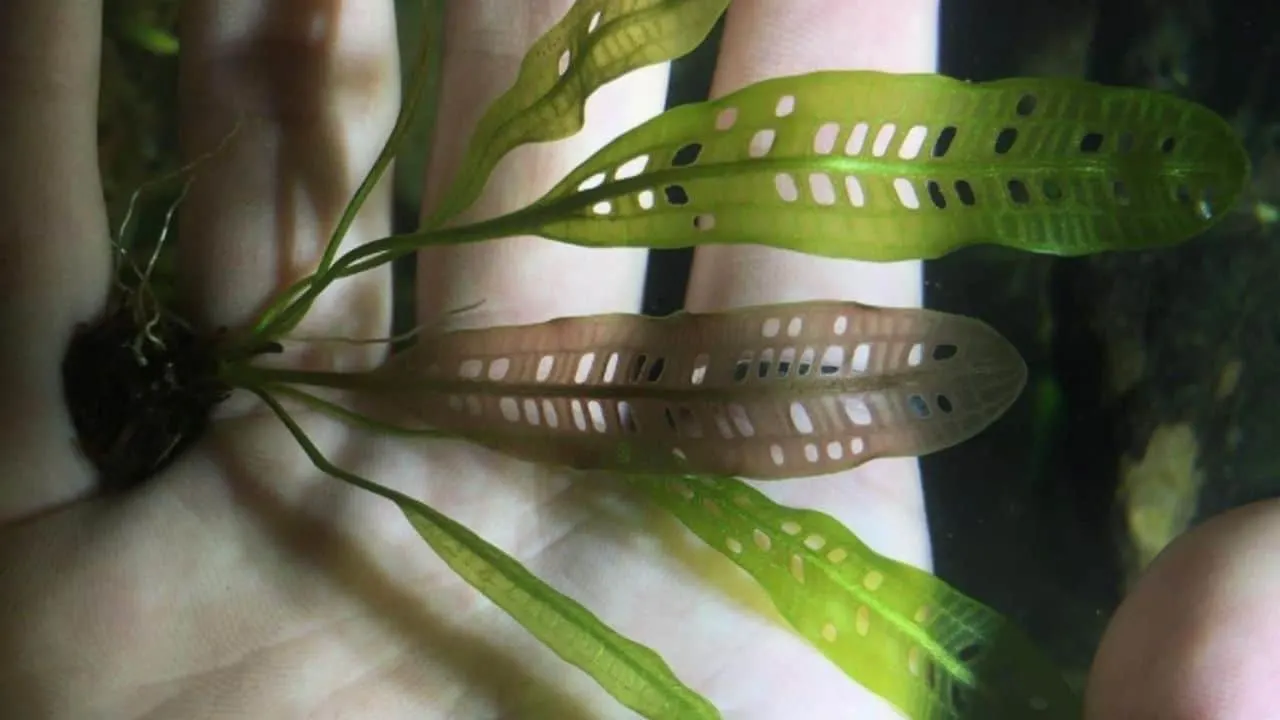
Photo Credit: @unso.fish.ticated on Instagram!
Madagascar Lace is known to grow well in a substrate such as gravel; however, it is not easy to care for this plant.
You will always have to make sure that you provide optimum conditions for this plant so that it grows well. Even slight changes in its surroundings can stunt the growth easily.
-
-
- Common name: Madagascar Lace
- Scientific name: Aponogeton Madagascariensis
- height: 8 inched (20 cm)
- Care: Easy
- Lighting needs: Low to Moderate
- Growth rate: Slow to Moderate
- Additional CO2 required: No
- Recommended position: Midground plant
- Fertilization: Root tabs
- Temperature: 60-70 degrees Fahrenheit (15-20 degrees Celsius)
-
Madagascar Lace is a large plant, but if you want it to be smaller, keep it under low light.
Furthermore, Madagascar Lace should always be planted properly into the gravel, and this is very important. Meaning it should be placed at least two inches deep in the gravel.
You must also make sure that you fertilize your Madagascar Lace regularly, as gravel does not have any nutrients.
Java Fern

Photo Credit: @emotionallyunstablefish on Instagram!
-
- Java Fern is another beautiful plant that grows well in gravel. This plant does not even need a lot of fertilizer, making caring for it even easier. You can grow it in your aquarium without giving it much attention.
-
-
- Common name: Java Fern
- Scientific name: Microsorum Pteropus
- Height: 13.5 inches (35 cm)
- Care: Easy
- Lighting needs: Low
- Growth rate: Slow
- Additional CO2 required: No
- Recommended position: Midground / Background plant
- Fertilization: Liquid fertilizer
-
Your fishes will love staying with this plant as the leaves of Java Fern are large and can provide a lot of coverage.
Java Fern does not grow fast, but as time passes, your whole tank will eventually get covered with this plant, and it will be a beautiful sight.
It also has a long life and grows quite large. While gravel can keep the roots planted down, there are still some drawbacks to it.
Be careful not to put your Java Fern too deep into the gravel as it can die.
Anubias
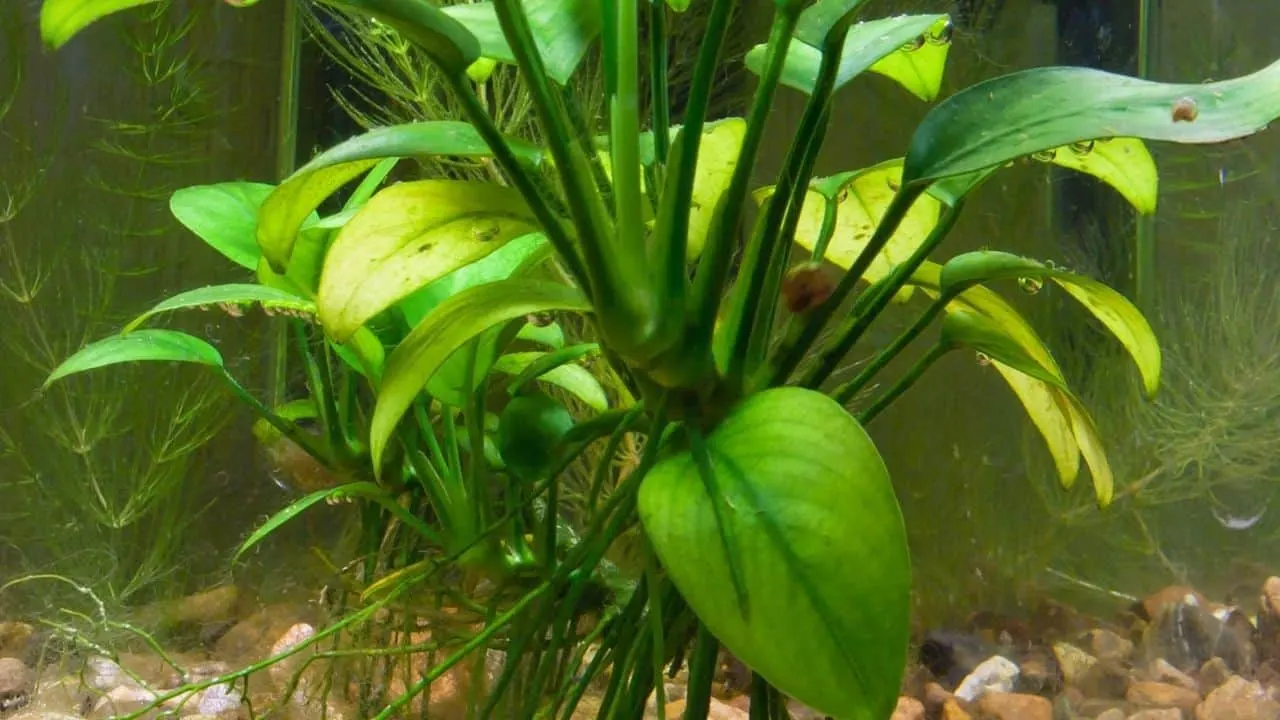
Anubias is a large plant that is known to provide the best shade for aquarium pets. They can survive well in gravel, but they do not like being buried too deep into it.
Generally speaking, Anubias is a hardy plant that only needs basic care.
-
-
- Common name: Anubias
- Scientific name: Anubias Barteri
- Height: 16 inches (40 cm)
- Care: Easy
- Lighting needs: Low
- Growth rate: Slow
- Additional CO2 required: No
- Recommended position: Midground or Background
- Fertilization: Liquid Fertilizer
-
Overall, it would be best if you give extra care to this plant. Anubias needs to be handled with a gentle hand when placed in the gravel.
Remember that you do not need thick layers of gravel.
Red Tiger Lotus
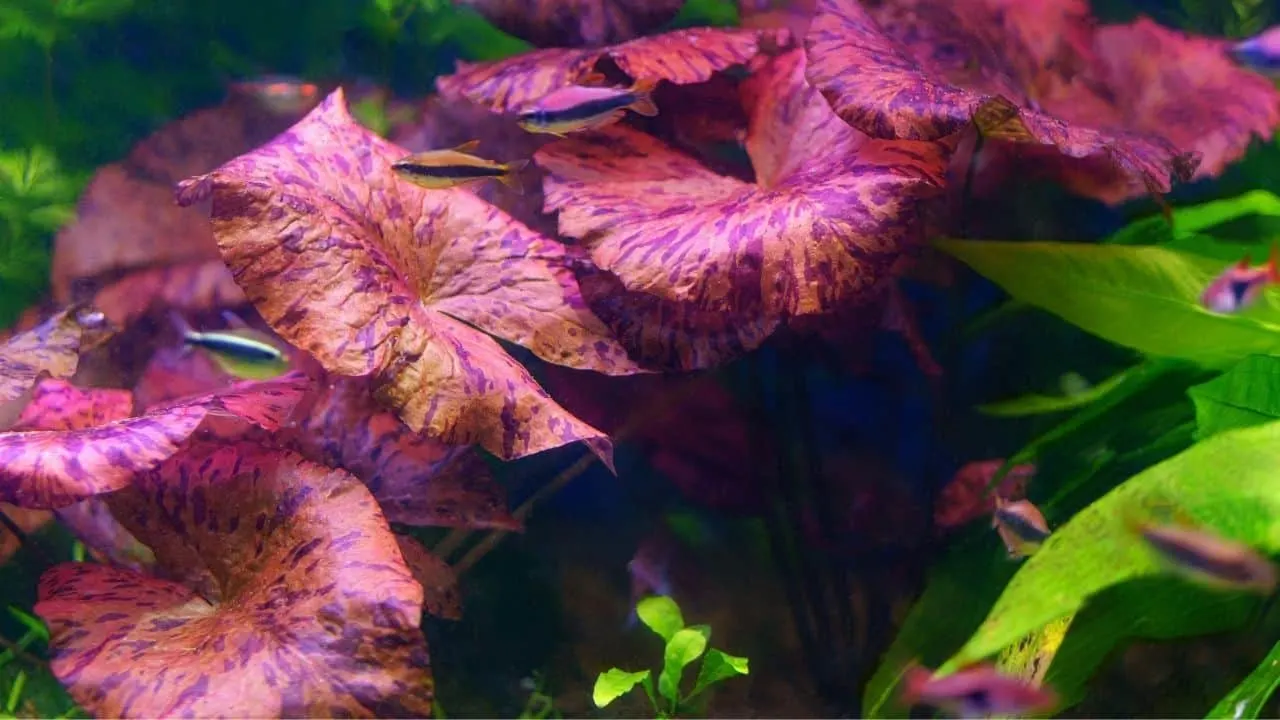
Red Tiger Lotus is a flowering aquarium plant that is capable of growing in gravel.
There is one drawback to planting it in an aquarium which is that it cannot bloom underwater. However, the Red Tiger Lotus plant also has stunning leaves to make up for it.
-
-
- Common name: Red Tiger Lotus, Dwarf Lilly
- Scientific name: Nymphaea Zenkeri
- Height: 20+ inches or 50+ cm (under ideal circumstances)
- Care: Moderate
- Lighting needs: Moderate to High
- Growth rate: Moderate to Fast
- Additional CO2 required: Yes (but can live without it)
- Recommended position: Midground or Background plant
- Fertilization: Root tabs and Liquid fertilizer
-
Just make sure that when you plant your Red Tiger Lotus in gravel, you provide it with plenty of fertilizer as this plant needs a lot of nutrients to survive in water, and gravel cannot fulfill these needs.
It requires some maintenance, but it is worth it.
Vallisneria
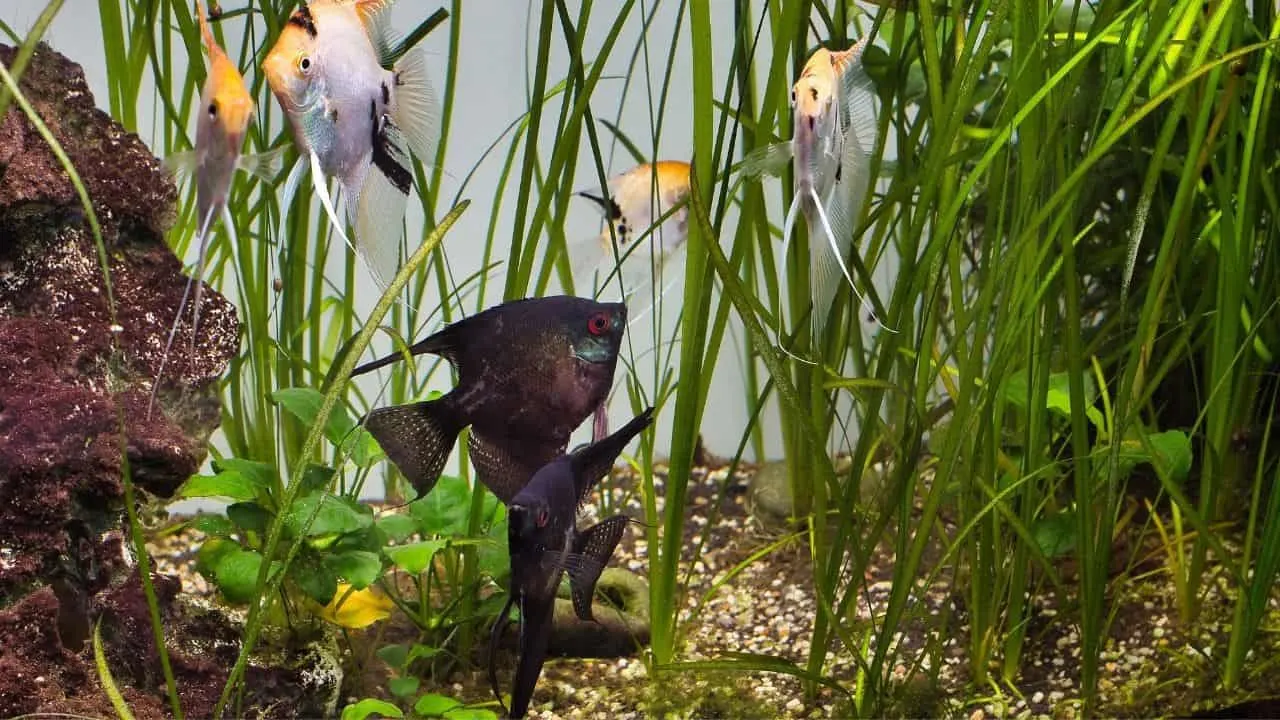
Vallisneria is a fast-growing plant that looks like grass. It is found in warm water and prefers tropical conditions.
Vallisneria is an undemanding plant and does not need a lot of things to grow well; thus, this makes it a perfect plant for growing in gravel.
You can decorate your tank with Vallisneria by planting it around the edges of the aquarium. Moreover, you can also place it as a blanket all over the tank.
-
-
- Common name: Vallisneria or Val
- Scientific name: Vallisneria Sp.
- Height: 8 to 16+ inches (20 to 40+ cm), but this depends on the variety of plant
- Care: Easy
- Lighting needs: Moderate to High
- Growth rate: Moderate to Fast
- Additional CO2 required: Not necessary
- Recommended position: Background plant
- Fertilization: Root tabs
-
Vallisneria does not need to be placed in a lot of gravel, and only a small layer of it is enough to make the plant root.
Just make sure the crown of your Vallisneria stays above the gravel because this is really important.
Bucephalandra
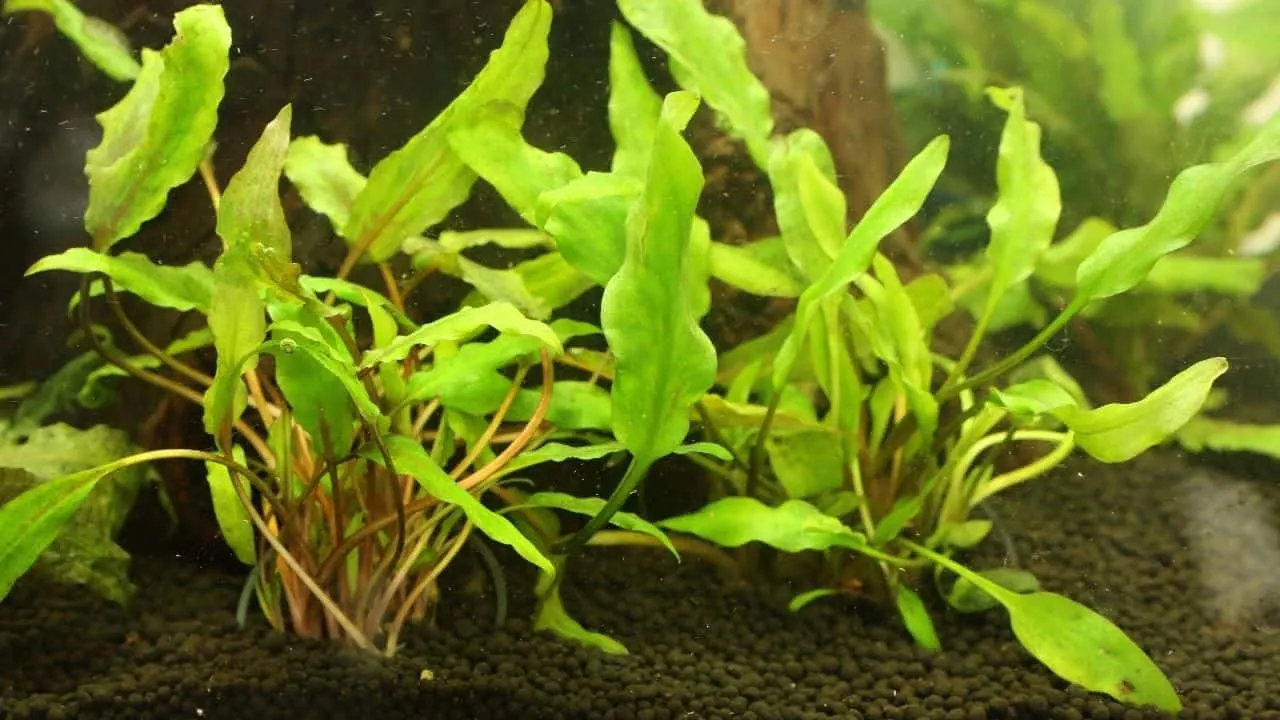
Bucephalandra is one of the few aquarium plants that require a thick amount of gravel to grow in.
You do not need large rocks as substrate, but you will need to add something larger than the normal gravel in the market.
-
-
- Common name: Bucephalandra
- Scientific name: Bucephalandra
- Height:4 inches (10 cm)
- Care: Easy
- Lighting needs:Low
- Growth rate: Slow
- Additional CO2 required: Not necessary
- Recommended position: Foreground or Midground plant
- Fertilization: Liquid fertilizer
-
Bucephalandra can also be found in many different colors.
If you provide the right amount of care, you will be able to grow Bucephalandra in red, pink, yellow, purple, green, glossy blue, and mixed colors.
Dwarf Sagittaria
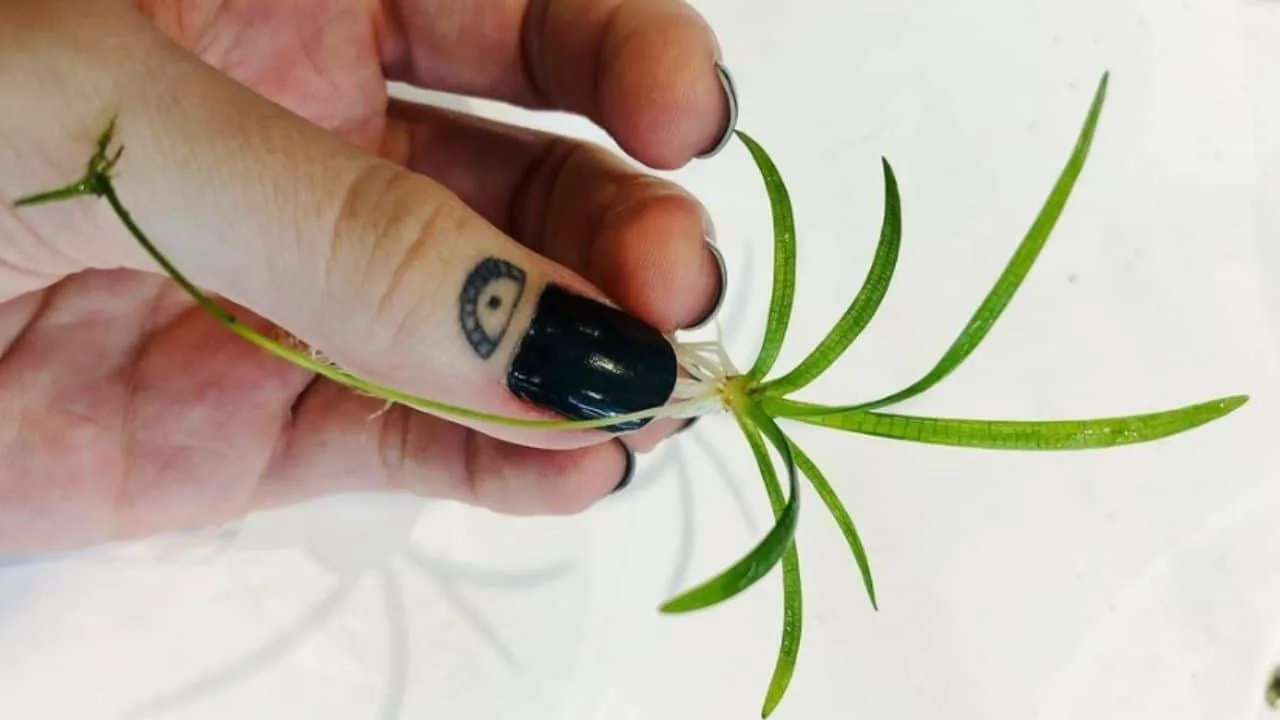
Photo Credit: @fishiotherapy.b on Instagram!
Dwarf Sagittaria is a plant that can adapt to almost any environment, making it a great choice when planting aquarium plants in gravel.
This plant is usually found in Columbia and America. However, in some countries like Indonesia and Portugal, they categorize this plant as invasive.
-
-
- Common name: Dwarf Sagittaria
- Scientific name: Sagittaria subulate or Sagittaria pusilla
- Height: 6 inches (15 cm)
- Care: Easy
- Lighting needs: Medium
- Growth rate: Fast
- Additional CO2 required: Not necessary
- Recommended position: Foreground or Midground plant
- Fertilization: Root tabs
-
When you get your Dwarf Sagittaria ready to plant, just make sure you provide a lot of nutrients in the gravel so that your plant grows well.
This plant requires a lot of fertilization, and if you do not provide it with enough iron, it will die.
Waterweeds (Anacharis elodea)

Waterweed is a plant found in South America. They are great for aquariums as they keep the water filtered and oxygenated and many aquatic buffs love having this plant in their aquariums.
It is capable of withstanding many water conditions and is not picky when it comes to water temperature.
-
-
- Common name: Brazilian Waterweeds
- Scientific name: Egeria densa
- Height: keep growing
- Care: Easy
- Lighting needs:Medium to High
- Growth rate: Fast
- Additional CO2 required: Not necessary (but it is beneficial to provide your Waterweeds with extra CO2)
- Recommended position: Background plant
- Fertilization: Liquid fertilizer
-
Make sure you place your Waterweeds roots deep into the gravel. They should be at least 1-2 inches deep into the substrate.
Thick layers of gravel are not bad for them. Just make sure that when you plant your Waterweeds in the gravel, they are at least one inch apart.
Java Moss
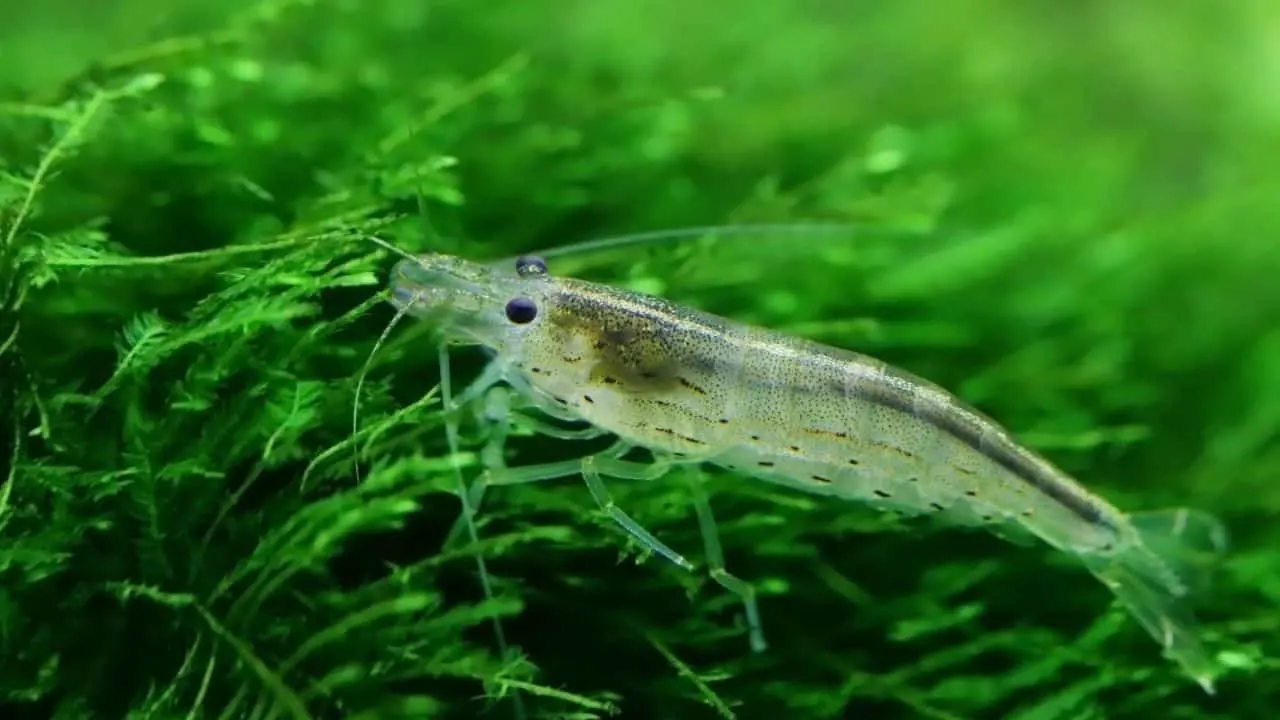
Java moss is a versatile plant that is used to decorate water tanks.
This is a very popular plant amongst hobbyists since it can live a long time and can withstand many different types of water temperatures so there is no maintenance hassle.
Java Moss is known to be an extremely hardy plant that’s able to withstand even the harshest conditions.
Its best features are that it is great in nano tanks and does not need any substrate for planting but can be planted in gravel.
Moreover, it can be attached to stones, driftwood, or any other ornament.
-
-
- Common name: Mini Moss
- Scientific name is Taxiphyllum barbieri
- Max height: 2–4 inches (5–10 cm)
- Care complexity: easy
- Water pH: 6.0 – 8.0.
- Lighting needs: Low light
- Growth rate: slow
- Additional CO2 required: does not need it
- Fertilization: not needed
- Temperature: 70-75 degrees Fahrenheit (21-24 degrees Celsius)
-
Java Moss can be kept in many different positions.
It can be used as carpeting in the tank or as tank wall decorations to amp up your aquarium setup.
Marimo Moss Ball
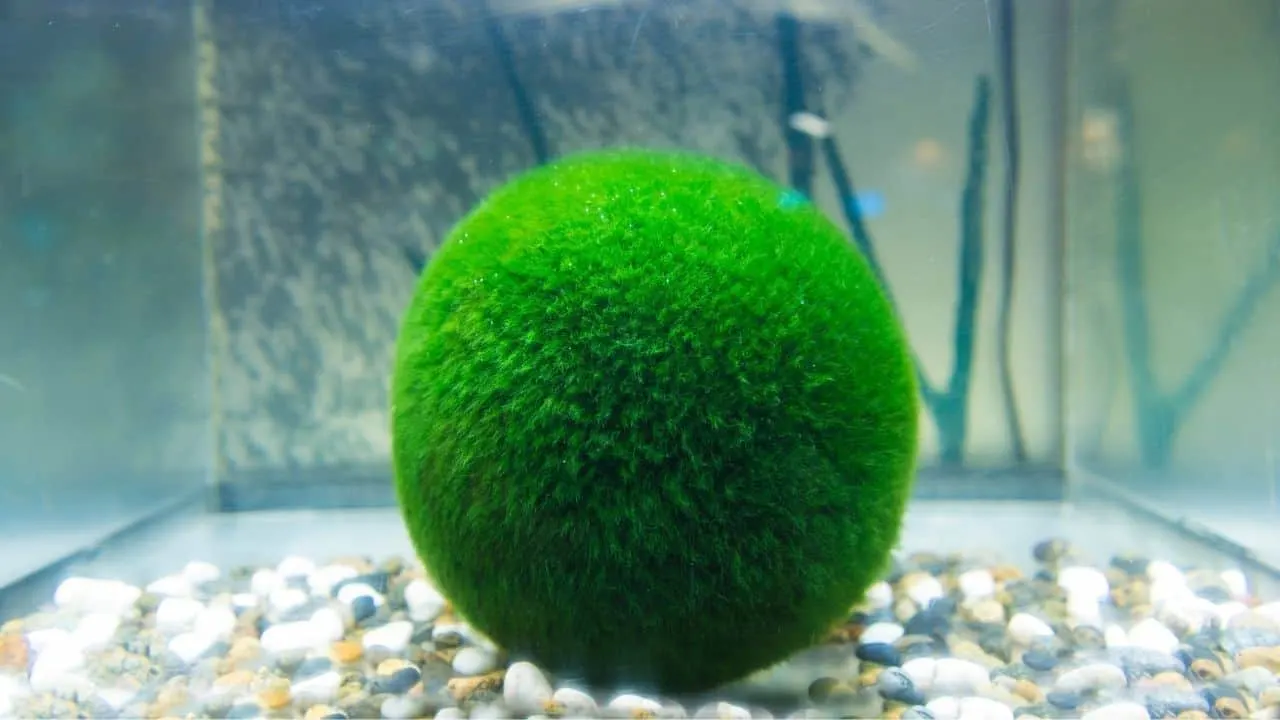
Marimo Moss Ball is actually not a plant, but in fact, they are green algae that can be grown as aquarium “plants.”
Thus, it can be grown in sand or even gravel as it is a hardy plant and does not give you much trouble.
-
-
- Common name: Marimo Moss Ball or Cladophora ball
- Scientific name: Aegagropila Linnaei
- Height: Depends on how you shape the plant
- Care: easy
- Lighting needs: low to medium
- Growth rate: extremely slow (about 5 mm or 0.2 inches per year).
- Additional CO2 required: not required
- Recommended position: anywhere
- Fertilization: fertilization is not required often but should be fertilized with liquid fertilizer
- Temperature:: 43 – 75 degrees Fahrenheit (5 – 24 degrees celsius)
-
Marimo Moss Ball is also known for many other things, such as having a long lifespan (can live up to 100 years) and growing without an air supply.
Moreover, the Marimo Moss Ball is great for aquascaping and does not need filtration.
Marimo Moss Ball is quite a unique “plant” and actually takes shape that you end up giving it. It can be kept as balls, or it can even be spread out on rocks.
Conclusion
The amount of gravel you use for each plant will vary greatly. Some plants need to be kept in a lot of gravel, while others need a little bit of it.
Large aquariums usually require a lot of gravel due to their size, but other factors such as plant type can also affect how much gravel you need to make your plant root.
Make sure that whatever plant you choose, you do thorough research and then plant it into gravel.
-

Daniel has been a plant enthusiast for over 20 years. He owns hundreds of houseplants and prepares for the chili growing seasons yearly with great anticipation. His favorite plants are plant species in the Araceae family, such as Monstera, Philodendron, and Anthurium. He also loves gardening and is growing hot peppers, tomatoes, and many more vegetables.

